Music of Brittany
Since the early 1970s,Brittanyhas experienced a tremendous revival of itsfolk music.Along with flourishing traditional forms such as thebombard-binioupair andfest-nozensembles incorporating other additional instruments, it has also branched out into numerous subgenres.
Traditional Breton music[edit]
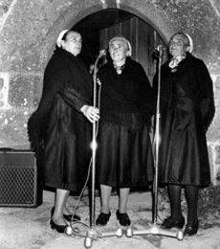
Traditional Breton folk music includes a variety of vocal and instrumental styles. Purely traditional musicians became the heroes of the roots revival in the second half of the 20th century, notably theGoadec sisters(Maryvonne, Thasie, and Eugénie). At the end of the 19th century, the vicomteTheodore Hersart de la Villemarqué's collection of largely nationalistic Breton songs,Barzaz Breiz,was also influential, and was partially responsible for preserving Breton traditions.[1]
Vocal music[edit]

Kan ha diskan(roughly translated ascall and responsesinging) is probably the most common type of Breton vocal music, and is the most typical style to accompanydance music.It has become perhaps the most integral part of the Bretonroots revival,and was the first genre of Breton music to gain some mainstream success, both in Brittany and abroad.
The lead singer is thekaner,and the second singer is thediskaner.Thekanersings a phrase, and thediskanersings the last few lines with thekaner,then repeats it alone until the same last few lines, when thekaneragain joins in. The phrase's repetition is changed slightly in each execution.Kan ha diskancan be songs about any subject, but must meet one of a number of meters used in folk dances, mostlylineorround.Vocables,or nonsense syllables (typicallytra la la la leh no), are sometimes used to drag outlines. Usually, akan ha diskanlasts from 5 to 20 minutes.
In addition to the Goadecs, the singerLoeiz Roparswas largely responsible for maintainingKan Ha Diskan's vitality in the middle of the 20th century, and the 1960s and 1970s revivalists drew largely on his work. They also venerated performers likeAr Vreudeur MorvanandLes soeurs Goadec/Ar c'hoarezed Goadeg.During the folk revival, aspiring musicians sought out elder teachers from whom to learnkan ha diskan,generally being viewed as successful when the student can act as adiskanerto their mentor. Teachers of this era includedMarcel GuillouxandYann-Fanch Kemener.
It was, however, Ropars who adapted thefest-noz,a "night party" in rural communities, for a new type of fest-noz (amplification for the singers), and set the stage for the folk revival.
Kantikoù (hymns)[edit]
Kantik( "canticle" ) is a type ofhymnthat is vocal but includes accompaniment from a variety of instruments, commonly including theharp,pipesandorgan.Modern performers includeAnne Auffretand the choirEnsemble Choral du Bout du Monde.
Gwerzioù and sonioù (laments and ballads)[edit]

Gwerzioùandsonioùare the two primary classifications of Breton unaccompanied folk songs. Vocals for both types are usually by a soloist. Agwerzis a lament characterized by a gloomy tone and subject matter. A Gwerz typically describes tragic events such as murders, deaths, wars, forced emigration or lost love.
Performers in this field includeJean Le MeutfromVannes,whose songs are mostly of thesonioùvariety, and are typically pastoral songs concerning love and marriage. More contemporary singers includeIffig Troadeg,who focuses on lyrically shocking gwerzioù,Patrick Marie,Marthe Vassalo,Klervi Rivière,Mathieu Hamon,Annie Ebrel,Erik MarchandandDenez Prigent.
Chants de marins (sailor songs)[edit]
Thechants de marins,areshanties,balladsaboutshipwrecks,sailing and loss of life, often accompanied by instruments such as thefiddleandaccordion.
Although it is not exclusively Breton, the large number of sailors in this region have given this form of musical expression a high-profile. The best known modern performers areDjiboudjepandCabestan,along with numerous but less known bands such asTonnerre de Brest,L'Echo,Les Boucaniers orTaillevent.There are new composers too:Michel Tonnerreis a well-known modern composer ofChants de marins;some of his compositions are as famous as ancient songs (Quinze marins,Satanicles,Vire au cabestan,Mon petit garçon).
There is an annualChants de marinscontest in the small town of Paimpol, in north Brittany, where the most famous shantymen of the world meet. At any harbour festival in BrittanyChants de marinscan usually be heard.
Instrumental music[edit]
Since the Breton folk music revival, Scottish bagpipes and Irish harps have been added to the Breton repertoire, though Brittany retains its own unbroken piping traditions as well as mainstay instruments such as the bombard.
Celtic harp[edit]

Though the harp had been common in Brittany in the Middle Ages[citation needed],the instrument had disappeared by the 18th century, at least in its specific repertoire and making. Early in the 20th century, a Breton harpistPaul Diverresliving in Wales came several times to play in Brittany. Just before and after the Second World War,Gildas Jaffrenoubuilt a harp from the 14th-century plans for theBrian Borumodel. But this was not enough for a revival.
In 1952–1953,Jord Cocheveloubuilt the first Breton new-Celtic harp. Since then and during the 50s, the Celtic harp or Breton harp has taken its place back into Breton music thanks to Jord and his sonAlan Cochevelou;Alan was the first person to play it in public and became world-famous under his stage nameAlan Stivell.
Modern Breton performers includeMyrdhin,An Triskell,Kristen NoguesandDominig Bouchaud.
Violin[edit]
Theviolinis an instrument played across France. Perhaps because of this wide-ranging appeal and lack of regional uniqueness, the instrument was somewhat ignored during the Breton folk revival in the mid-20th century. However, the instrument remains a common part of Breton folk bands today.
The violin has been played in Brittany since at least the 17th century, and was possibly the most widespread instrument in the land by the early 20th century. It was only a few decades later, however, that the accordion nearly wiped the violon out, and most fiddlers joined Irish bands, moved into jazz or otherwise left the instrument. The violon survived, however.Alan Stivellhas used the fiddle and electric violin in his arrangements and compositions since his first album in 1970, inviting different fiddlers for his tours and records. It opened the way for a new generation of performers includingChristian Lemaitre,Jackie Molardand the six-violin bandArchétype.
Clarinet (treujenn-gaol)[edit]
Theclarinetwas invented inGermanyin the 18th century. It evolved from earlier single reed instruments such as the renaissance chalumeaux, or schalmei. Clarinets were quickly incorporated intoorchestras,from where they moved intomarching bandsand the amateur musicians in them. By the 19th century, the clarinet had entered a number of folk traditions and spread to many parts of the world. In Brittany, the instrument is called atreujenn-gaol(Breton), which translates ascabbage stalk.
The traditional Breton clarinet usually has only 13 keys (though sometimes as few as six), in contrast to the more common 'Boehm' instrument used in jazz, classical music and other fields. This is because classical musicians discarded the clarinets with fewer keys in favor of more complex and state-of-the-art pieces.
After a decline in use in traditional music, the instrument came back, notably in the music of thebagadand paired with the accordion.
In Breton music, two clarinetists typically play together, though they also play in ensembles withaccordionsandviolins.The clarinet is a common part of Breton jazz bands, along withsaxophonesanddrums,playing both jazz and traditional songs.
The best-known Breton clarinetists are probablyErik Marchand,a former member of bothQuintet ClarinettesandGwerz,Gallo musician Yves LeBlanc, and Christian Duro, who plays in the group Termajik. The bands Darhaou,Tonnerre de Brest,L'Echo,CabestanandStrobinellhave also used clarinets.
Guitar[edit]
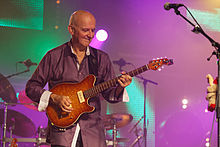
Perhaps the earliest popularizer of Breton guitar was Dan Ar Braz, who continues to be an influential figure in a somewhat jazzy, easy-listening vein. In the traditional music world,Soïg Siberilemerged as the pre-eminent master of 'open tuning' in bands such as Gwerz and Kornog, developing a complex accompaniment and solo technique easily comparable to that of artists such asJohn RenbournorPierre Bensusan.Another guitarist of note isGilles Le Bigot,who performed with Kornog as well and has been a mainstay of the Breton super-group Skolvan for more than 20 years. Other notable Breton guitarists includeJacques Pellen,Pat O'May,Nicolas Quemener,Fabrice Carre,Roland ConqandArnaud Royer,who has developed a unique and complex self-accompaniment technique based on sampling and then playing along with loops of his own work.
Wooden flute[edit]
The wooden transversefluteentered Brittany only relatively recently, popularized byJean Michel Veillon.Veillon has been a member of a number of prominent bands, includingPennoù Skoulm,Barzaz,DenandKornog,as well as producing some influential solo albums. Other performers include Youenn Le Cam ofPevar Den,Jean Luc Thomas ofKej,Yannig AloryofCarré Manchot,Yann Herri Ar GwicherofStrobinellandHervé GuilloofStorvan,and alsoGilles Lehart,who is one of Brittany's most respected wooden flute makers.
Accordion[edit]
The accordion only arrived in large numbers in the country in about 1875, but its popularity grew quickly. Among the reasons for this were the instrument's cheapness and durability, which could be played solo, and was easier to learn. Perhaps the most important reason, though, was the instrument's association with 'kof ha kof' couples dancing likewaltzesandmazurkas,which stood in stark contrast to the line and round dances familiar in Breton folk; the perceived sexuality of the instrument's common dances may have made it more attractive. By the 1920s, the instrument was more popular than any other. In the 1930s, chromatic accordions arrived in Brittany andjazz-influenced bands withsaxophones,drum kitsandbanjoswere formed.
Contemporary accordionists includeCocktail Diatonique,Regis Huiban,Bruno Le Tron,Patrick Lefebvre,Yann Dour,Yann-Fañch PerrochesandAlain Pennec.
Bagpipes[edit]

There are two types of bagpipes indigenous to Brittany. Theveuzeis very similar to other western European bagpipes such as the Gaita from Galicia and Asturies, while thebinioukozh (old biniouin Breton) is much smaller and is used to accompany thebombarde.The biniou, which plays exactly oneoctaveabove the bombarde, and bombarde duo (soner ar couple) are an integral and common part of Breton folk music, and was used historically for dance music. The two performers play alternate lines that intersect at the end, in a similar manner to the Kan ha Diskan style of singing; the bombarde does not usually play every line of the tune, however, usually instead playing every other line, or three out of four lines in a dance tune. The Highland bagpipe, which was imported in the late 19th century, is often calledbinioù braz,sometimespib-veur(the large biniou, the large pipe). The image to the right shows the binioù braz, or highland bagpipes, with bombardes in the hands of the men in the background.
Veuze[edit]
Theveuzehas a chanter of conical bore fitted with adouble reedand a drone fitted with one reed, both attached to a mouth-inflated bag. Its sound and design are similar to Flemish pipes andGalician gaita.In the 20th century, the termveuzecame to be applied to the diatonicaccordion,which had been recently imported, and the use of the bagpipes declined. Though still not common, it has rebounded since the Breton folk revival.
Binioù bras[edit]
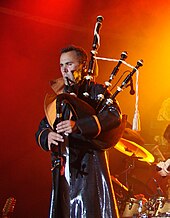
Thebinioù bras(literally the "big binioù" ), orGreat Highland bagpipe,was imported in the late 19th century, and became popular in the 1930s. It is now used in solo performances, along with a bombarde in a duo, and as part of thebagad,a kind ofpipe band.
The idea of thebagadcomes fromWorld War II:Breton soldiers saw pipe bands in Scotland, and brought the idea and instrument back with them to Brittany. There, they added bombardes along with the bagpipes drums and called the ensemblebagad( "company" in Breton). These ensembles gained in popularity in the 1950s, just before the folk revival began, and remain very popular to this day.
Binioù kozh[edit]
Thebinioù kozhis more traditional and predates the introduction of the highland bagpipes to Brittany. It was originally designed from theveuzein order to play in a higher register. Its pitch is higher and its chanter smaller than any other European bagpipe. Originally, it was common in the Breton-speaking area. It is often played as part of a duo with the bombarde, for dance accompaniment.
Bombard[edit]
Thebombard(Breton, Fr.bombarde) is a conical-bore double-reed instrument similar to theoboe,and like an oboe uses reeds made of cane.
In its most primitive form the bombard has six open holes and possibly a seventh that is often closed with a key. It has a range of just over an octave. Bombards come in a number of keys, based on region or intended use. B-flat is a popular choice for those playing in a Bagad alongside thebinioù braz(Scottish Highland pipes). In the contemporary setting bombards may also have complex simple system key-work enabling significant chromatic possibilities. In Breton, the bombard is also known as thetalabard,and a bombard player as atalabarder.
The bombard has been in use since the 15th century, and has traditionally been played as part of a duo with the binioù kozh since theFrench Revolution.Later, in the 19th century, thebinioù braz(highland bagpipe) was introduced to Brittany.
Biniou and bombarde duos includeJean BaronandChristian Anneix,Youenn Le BihanandPatrick Molard,andPierre CrépillonandLaurent Bigot.
In recent years the bombard has been paired and recorded with other instruments not traditionally associated with Breton folk music, such as the organ. Sacred music is well served by the clear, strong sound of the bombard, in combination with the traditional organ. The late Jegat and Yhuel are renowned for this use of the bombard.
Piston[edit]
Breton musician, teacher, and luthier Youenn Le Bihan invented thepistonin 1983. The piston is a contemporary development of the hautboy or baroque oboe, influenced by the bombard. It is typically rooted in the key of D and features simple system key-work to expand its range. The tone of the piston stands in a warm and rich middle ground between the trumpet-like tone of the bombard and that of the baroque oboe.
Breton pop music[edit]
This sectionmay be a roughtranslationfrom French.It may have been generated, in whole or in part, by a computer or by a translator without dual proficiency.(September 2022) |
This sectionneeds additional citations forverification.(September 2022) |
Undoubtedly the most famous name in modern Breton music isAlan Stivell,who popularized theCeltic harpfirst in the fifties and sixties and on a wider level since the 1970s, with a series of albums including most famouslyRenaissance de la Harpe Celtique(1971). His first harps were built by his father; the Celtic harp was long forgotten in Brittany before.
In 1955, he began playing thebombarde,a smaller version of the double-reededshawm(which later evolved into theoboe). Later, he took up the Scottish bagpipe and became pipe major. Alan Stivell began (in the mid-60s) recording Breton folk, Celtic harp, and other Celtic music, mi xing influences fromAmericanrock and rolland the main musical genres.
February 28, 1972, marks the unprecedented performance of the Breton musician, at theOlympiaMusic Hallin Paris, broadcast live on one of only three radio networks in France (seven million listeners onEurope 1radio).Tri Martolod,Suite Sudarmoricaine,An Alarc'h,andPop Plinnbecame famous hymns. TheOlympia albumsold a staggering 1,500,000 copies. If his work as composer, producer, and author has been very important, so has been his work of promotion and communication to the major audiences, in Brittany, France, Europe and the English-speaking countries.
Stivell's most important contribution to the Breton music scene, however, has probably been his importation of rock and other American styles, as well as the formation of the idea of a Breton band. From the albumRefletsto the new oneExplore,without forgetChemins de Terre(1973),Alan Stivellhas made 22 albums and toured all over the world, influencing many musicians everywhere, experimenting with many different fusions (Rock,Jazz-rock,Blues, Symphonic, Indian, African, Electro, Hip-hop, etc.).
Inspired byAlan Stivell,a very large Breton scene grew up, especially after hisOlympia concertin 1972. It was a true revolution: hundreds of bands, thousands of musicians, of Festoù-noz, etc. grew in the year after. Bands likeKornogandGwerzarose, adapting elements of the Irish and ScottishCeltic musicscene.

The most famous group of Breton musicians after Alan Stivell isTri Yann,fromNantes(their original name isTri Yann an Naoned,literally "the Three Johns from Nantes" ). They formed in 1972 and still remain very popular, describing themselves as producingprogressive rock-folk-celto-medievalmusic. They have produced some musical gems, now standards, like "Les filles des Forges","Les prisons de Nantes","La Jument de Michao","Pelot d'Hennebont",and new interpretation of Irish music, like"Cad é sin don té sin","Si mort a mors"(originallyAn Cailín Rua), "La ville que j'ai tant aimée"(from" The town I loved so well ")," Mrs McDermott "(from the 17th-century Irish harpistÓ Carolan) and "Kalonkadour"(from"Planxty Irwin").
Another famous band isSoldat Louis,fromPort Louis,across the harbour from the city ofLorient.More rock-oriented, they play modern compositions about Brittany and life on the sea ( "Du rhum, des femmes","Martiniquaise","Pavillon noir"). Also from the 80s,Ar Re Yaouankplayed lively driving folk rock songs with pro-Breton themes.
Red Cardellcrosses over roots music fromBrittany,UkraineorNorth Africawith Rock and French realistic songs. Many times they play on stage with guests such asDave Pegg(Fairport Convention,Jethro Tull), Jimme O'Neill (The Silencers),Dan Ar Braz,Dr Das (Asian Dub Foundation) or Stéfane Mellino (Les Négresses Vertes)... Their album "soleil blanc" has been recorded and mixed by the English producer Clive Martin (Queen,Sting,David Byrne...) Similarly,EVcombined Finnish influences in their Breton folk-rock style, calling it Celto-Finnic rock.

Since then, a new scene of Breton songwriters appeared in Brittany (Gérard Jaffrès,Nolwenn Korbell,Dom Duff).
Les Ramoneurs de menhirsdoCeltic punk,playing original songs, traditional ones and cover versions mostly inBreton.
Besides folk-rock, recent groups have included, as well asAlan Stivell,world music influences into their repertoires – especially younger groups such asWig-a-Wag.Hip hopwith a Celtic flavour has been espoused by groups such asManaufrom Paris.
The band Merzhin uses traditional Celtic instruments along with electric guitars and bass. Their melodies and harmonies are inspired by Celtic music as well as by modern rock and roll.[2]
In the USA, the groupTrouz Bras( "Big Noise" ) is led by Welshman Ray Price. The group is based in Rhode Island and features bombarde and Breton bagpipes. In Seattle, Washington a Fest Noz group calledSonerionfeatures piston, bombard, guitar/bouzouki, accordion, and bass. In Austin, Texas, Poor Man's Fortune[1]is well known for performing Breton music featuring biniou, bombarde, accordion, subois (similar to the "piston" ), violin, flute and biniou braz.
Brittany hosts many annual rock and pop festivals, not related to traditional music. The biggest in Brittany and France, and one of the most important in Europe, is theFestival des Vieilles Charrues(held in late July in Carhaix, Finistère). See also theRoute du Rock(mid-August,Saint-Malo) and theTransmusicalesofRennes,held in early December.
For its 2014 edition, theFestival des Vieilles Charrues(The festival of old plows) announces its new creation:The Celtic Social Club,a supergroup of seven Breton musicians and others, which included Jimme O'Neill (The Silencers), Ronan Le Bars (Héritage des Celtes) and the three members ofRed Cardell.
Chanteurs engagés[edit]
Achanteur engagé(literally[ideologically] engaged singer) is a singer who is roughly analogous to a singer ofprotest songs.These songs are usually nationalistic and are celebrations of Breton culture. This is mostly a modern tradition, though some older songs of this type are known and the tradition stretches into the ancient past of Brittany.Chanteurs engagésare often also singers of more traditional material.
The firstchanteur engagéto be quoted is the maverickGlenmor(1931–1996), or to give him his real name, Emile Le Scanf (orMilig Ar Scañvin Breton). He had some influence, mainly in the Breton movement and around, and on some newcomers as the best known,Gilles Servat,whose "La Blanche Hermine"has been a popular Breton anthem since the 1970s.
Gallo[edit]

Though the Breton folk revival focused on songs inBreton,thePays Galloarea of eastern Brittany has seen a more limited revival in repertoire inGalloand produces singers and groups includingHamon-Martin Quintet,Ôbrée Alie,Yann Dour,while various bands, such asTri Yann,perform a selection of Gallo songs.
Breton artists[edit]
Breton singers and musicians[edit]
- Jean-Michel Alhaits
- Dan Ar Braz(guitar, voice)
- Andrea Ar Gouilh(voice)
- Anne Auffret(voice)
- Stéven Bodénès(bombard)
- Jorj Botuha
- François Budet

- Kevin Camus(uilleann pipes)
- Louis Capart(voice)
- Jean-Michel Caradec(voice)
- Cécile Corbel(harp, voice)
- Dom Duff(voice)
- Didier Dréo(guitar)
- Annie Ebrel(voice)
- Louise Ebrel(voice)
- Yvon Etienne(voice)
- Yffig Flatrès(voice)
- Glenmor(voice)

- Soeurs Goadec(Goadec sisters), (voices)
- Brieg Guerveno(guitar, voice)
- Frères Guichen(Guichen brothers), (guitar, accordion)
- Gwenynn(voice)
- Youenn Gwernig(voice)
- Gérard Jaffrès(guitar, voice)
- Yann-Fañch Kemener(voice)
- Nolwenn Korbell(voice)
- Krismenn(voice)
- Pascal Lamour(voice)
- Clarisse Lavanant(voice)
- Ronan Le Bars(uilleann pipes, Low whistle)
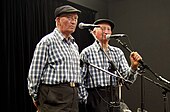
- Jean-Louis Le Hénaff(bombard)
- Gilles Lehart
- Hervé Le Meur(bagpipe)
- Nolwenn Leroy(voice)
- Erik Marchand(voice)
- Patrice Marzin(guitar)
- Miss Blue(DJ)
- Christophe Miossec(voice)
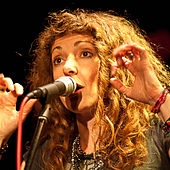
- Gildas Moal and Rene Chaplain
- Jean-Michel Moal(accordion)
- Jacky Molard(violin)
- Frères Morvan(voices)
- Kristen Nikolas(voice)
- Jacques Pellen(guitar)
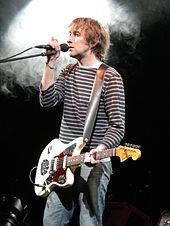
- Yann-Fañch Perroches
- Denez Prigent(voice)
- Loeiz Ropars(bagpipe)
- Erwan Roparz(bagpipe)
- Jean-Luc Roudaut(voice)
- Soig Siberil(guitar)
- Didier Squiban(piano)
- Alan Stivell(harp, bombard, voice)
- Bernez Tangi(voice)
- Yann Tiersen(violin, accordion, guitar)
- Michel Tonnerre(voice)
- Marthe Vassalo(voice)
- Jean Michel Veillon(flute)
- Wonderbraz(DJ)
Breton bands[edit]
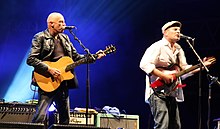
- Armens
- Ar Re Yaouank
- Bleizi ruz
- Cabestan
- Carré Manchot
- The Celtic Social Club
- Daonet
- Diaouled Ar Menez
- Diwall
- Djiboujet
- EV
- Forzh Penaos
- Gweltaz Ar Fur
- Gwendal
- Gwenfol
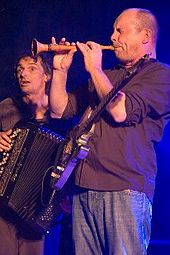
- Kern
- Kreiz Breizh Akademi
- Matmatah
- Merzhin
- Octopus Kafé
- Penn Gollo
- Plantec
- Les Ramoneurs de menhirs
- Red Cardell
- Skeduz
- Skolvan
- Soldat Louis
- Sonerien Du
- Startijenn
- Storlok
- Tri Yann
Breton bagads (Pipe bands)[edit]

- Bagad An Hanternoz
- Bagad Ar Meilhoù Glaz
- Bagad Ar Re Goz
- Bagad Beuzeg ar C'hab
- Bagad Bleimor
- Bagad Blouarzel
- Bagad Brieg
- Bagad Bro Felger
- Bagad Bro Kemperle
- Bagad Bro Landerne

- Bagad Cap Caval
- Bagad de Cesson-Sévigné
- Bagad Elven
- Bagad Eostiged Ar Mene
- Bagad Ergué-Armel
- Bagad Glaziked Pouldergat
- Bagad Gwengamp
- Bagad Kadoudal
- Bagad Karreg An Tan
- Bagad Karaez
- Bagad Kemper

- Bagad Keriz
- BagadKerlenn Pondi
- BagadKevrenn Alre
- BagadKevrenn Brest Sant Mark
- Bagad Kombrid
- Bagad Konk Kerne
- Bagad Landi
- Bagad de Lann-Bihoué
- Bagad Melinerion
- Bagad Naoned
- Bagad Pãnvrid
- Bagad Penhars

- Bagad Plougastell
- Bagad Quic-en-Groigne
- Bagad Roñsed-Mor
- Bagad Sant-Brieg
- Bagad Saint-Nazaire
- Bagad Sonerien An Orient
- Bagad Sonerien Bro Dreger
- Bagad Spered An Avel
References[edit]
- ^SeeFest Noz Spezet.
- ^"Merzhin.Net - le site officiel de Merzhin".Archived fromthe originalon 28 August 2002.
Sources[edit]
- Jonathyne Briggs,Sounds French: Globalization, Cultural Communities, and Pop Music in France, 1958-1980,Oxford University Press,2015, Chapter 4 "Sounds Regional: The World in Breton Folk Music"ISBN9780199377091
- Winick, Stephen D. "Brittany". 2001. In Mathieson, Kenny (Ed.),Celtic music,pp. 110–139. Backbeat Books.ISBN0-87930-623-8
- Ronan Gorgiard "L'étonnante scène musicale bretonne",Palantines(Ed.), collection: Culture et patrimoine, 2008, 255 pages.ISBN978-2-911434-98-3
Films[edit]
- Of Pipers and Wrens(1997). Produced and directed by Gei Zantzinger, in collaboration with Dastum. Lois V. Kuter, ethnomusicological consultant. Devault, Pennsylvania: Constant Spring Productions.

